This article was co-authored by Rendy Schuchat. Rendy Schuchat is a Certified Professional Dog Trainer and the Owner of the largest dog training facility, Anything Is Pawzible, based in Chicago, Illinois. With over 20 years of experience, Rendy specializes in positive dog training and behavior modification to help people build and strengthen their relationships with their dogs. She holds a BA in Psychology and Communications from the University of Iowa, an MA in Psychology from Roosevelt University, and a Certification in Dog Obedience Instruction from Animal Behavior Training and Associates. Rendy was voted one of the Best/Favorite Dog Trainers in Chicago by Chicagoland Tails Reader’s Choice Awards multiple times and was voted Chicago Magazine’s “Best Dog Whisperer” in 2015.
This article has been viewed 26,671 times.
To ensure that your dog has good dental health, keep your dog’s teeth and gums clean by regularly brushing your dog's teeth. It is recommended that you brush your dog’s teeth daily with an absolute minimum of three times per week. Brushing a dog’s teeth is unnatural for dogs, so you will need to first acclimate your dog to the process. Once your dog is familiar with the process, then you can begin to clean your dog’s teeth with a dog toothbrush and toothpaste.
Steps
Acclimating Your Dog to Brushing
-
1Buy a dog toothbrush and toothpaste. Do not use human toothpaste or toothbrushes to clean your dog’s teeth. Human toothpaste contains high amounts of fluoride, which is poisonous to dogs. Visit your local pet supply or pet grooming store to purchase dog toothpaste and a toothbrush. You can also make your own doggie toothpaste by mixing baking soda with water.[1]
- Mix a tablespoon of hot water with two tablespoons of baking soda. To add freshness to the paste, add a pinch of cinnamon to the mix.
-
2Choose a calm time. Bring your dog to the bathroom, or an area away from noise and commotion, and close the door. Also, choose a space that has good lighting so you can inspect your dog’s teeth thoroughly.[2]
- Bring some doggie treats with you so you can reward your dog for good behavior throughout the process.
Advertisement -
3Massage your dog’s lips. Get your dog accustomed to having its teeth brushed by massaging your dog’s lips with your finger, first. Massage your dog’s lips in a circular motion for 30 to 60 seconds once per day for a week.[3]
- This step is especially important if your dog has an adverse reaction to its mouth being touched. If your dog has an adverse reaction, stop what you are doing. Try again after a minute.
- Reward your dog with a treat for good behavior.
-
4Begin to touch the teeth and gums without the brush.[4] The following week, move on to touching your dog’s teeth and gums with your finger. Wrap your finger in gauze. Lift and hold your dog’s upper lip. Gently rub your finger in a circular motion over your dog’s upper teeth. Do this for 30 seconds.[5]
- Hold down your dog’s lower lip and apply the same circular motion to its bottom teeth for 30 seconds.
- Practice doing this once a day for a week. Remember to give your dog a treat for good behavior afterwards.
-
5Place toothpaste on your finger. Introduce the toothpaste to your dog by placing some on your finger. Let your dog smell and lick the toothpaste from your finger. By doing this, your dog will get used to the taste and texture of the toothpaste.[6]
- You can do this either before or after you massage your dog’s teeth with your finger.
-
6Touch the toothbrush to the teeth.[7] Introduce the toothbrush by touching the front, side, and back teeth with the brush. Touch both top and bottom teeth with the brush. Do this for 30 seconds on both top and bottom teeth once per day for a week.[8]
- Make sure to reward your dog for good behavior afterward.[9]
Brushing Your Dog’s Teeth
-
1Let your dog lick toothpaste from your finger. Once your dog is familiar with the whole process, you can begin to brush its teeth. Before you start, place a dab of toothpaste on your finger and let your dog lick it off. Then, place more toothpaste on the toothbrush.[10]
-
2Hold the upper lip. At a 45-degree angle, place the toothbrush on its upper teeth while holding its lip. Massage the teeth with the toothbrush in small, circular motions, just like you practiced. The sides of the teeth that touch the lip will have the most plaque and tartar build-up. Focus on these areas. Only work on small areas at a time, lifting your dog’s lip as necessary.[11]
- When removing tartar and plaque, use downward strokes for the top teeth.
- Hold down your dog’s bottom lip and massage the outsides of the bottom teeth in the same circular motion. Use upward strokes to remove tartar from the bottom teeth.
-
3Brush the inside of the teeth. Once you have cleaned the outsides of the teeth, attempt to brush the insides of the teeth.[12] Your dog might resist. If it does, don’t fight your dog, but cease from brushing. Only small amounts of tartar accumulate on the insides of the teeth. Therefore, it is not as important as the sides of the teeth.[13]
- Don’t forget to reward your dog for good behavior afterwards.
Understanding Basic Dental Care for Dogs
-
1Brush at least three times a week. It is recommended that you brush your dog’s teeth daily, but at least three times a week. Since smaller dogs are more likely to develop dental issues, it is recommended that you brush their teeth every day or at least five times a week.[14]
- Healthy gums are pink, not cherry red or white, and show no signs of swelling or bleeding.
-
2Purchase chew toys. Nylon, rubber, or toxin-free rawhide chew toys are also a great way to keep your dog’s teeth and gums strong and healthy.[15] Chewing on a toy can help massage the gums and scrape away soft tartar.[16]
- Reward your dog with treats that are specially formulated to keep your dog’s teeth healthy.
- Chew toys and soft chews should not replace regular brushing.
-
3Consult your vet. Have your vet examine your dog’s teeth to rule out any existing infections or diseases.[17] Ask your vet about the dental care your specific dog’s breed needs. Some dogs, especially smaller dogs, are more prone to dental diseases and infections, like gingivitis and gum disease. Your vet can recommend a teeth-cleaning regimen that caters to your dog’s needs.[18]
- Take your dog to the vet immediately if it is suffering from any of these symptoms: inflamed or swollen gums, loose or decayed teeth, tooth pain, i.e., pawing at the mouth, lumps in the gums, i.e., mouth tumors, or fluid filled blisters under the tongue or near the corners of the jaw, i.e, salivary cysts.
Expert Q&A
-
QuestionWhat if my dog doesn't like the toothbrush?
 Osama MaghawriOsama Maghawri is a Dog Trainer and Founder of OneStopK9, a dog training service in Miami, Florida. Osama utilizes balanced training methods to teach communication between owners and dogs. He specializes in basic obedience and behavioral issues such as resource guarding, fear-based aggression, and leash reactivity. Osama also helps owners understand the behaviors of their breed and how to continue training on their own in the future.
Osama MaghawriOsama Maghawri is a Dog Trainer and Founder of OneStopK9, a dog training service in Miami, Florida. Osama utilizes balanced training methods to teach communication between owners and dogs. He specializes in basic obedience and behavioral issues such as resource guarding, fear-based aggression, and leash reactivity. Osama also helps owners understand the behaviors of their breed and how to continue training on their own in the future.
Professional Dog Trainer If your dog doesn't like the toothbrush, consider using a rubber finger toothbrush to make the process easier.
If your dog doesn't like the toothbrush, consider using a rubber finger toothbrush to make the process easier. -
QuestionWhat can I do if my dog doesn't like getting his teeth brushed?
 Osama MaghawriOsama Maghawri is a Dog Trainer and Founder of OneStopK9, a dog training service in Miami, Florida. Osama utilizes balanced training methods to teach communication between owners and dogs. He specializes in basic obedience and behavioral issues such as resource guarding, fear-based aggression, and leash reactivity. Osama also helps owners understand the behaviors of their breed and how to continue training on their own in the future.
Osama MaghawriOsama Maghawri is a Dog Trainer and Founder of OneStopK9, a dog training service in Miami, Florida. Osama utilizes balanced training methods to teach communication between owners and dogs. He specializes in basic obedience and behavioral issues such as resource guarding, fear-based aggression, and leash reactivity. Osama also helps owners understand the behaviors of their breed and how to continue training on their own in the future.
Professional Dog Trainer I suggest taking things slowly so your dog can get used to the process. Start by simply getting your dog to sniff the toothbrush, then reward him for it. Then, move on to rewarding your dog for touching the toothbrush with his teeth. Keep doing this until your dog feels totally comfortable with the toothbrush. It may take some time, but treats will help keep his motivation up!
I suggest taking things slowly so your dog can get used to the process. Start by simply getting your dog to sniff the toothbrush, then reward him for it. Then, move on to rewarding your dog for touching the toothbrush with his teeth. Keep doing this until your dog feels totally comfortable with the toothbrush. It may take some time, but treats will help keep his motivation up!
References
- ↑ https://www.aspca.org/pet-care/dog-care/dog-grooming-tips
- ↑ https://www.akc.org/expert-advice/health/how-brush-dog-teeth/
- ↑ https://www.aspca.org/pet-care/dog-care/dog-grooming-tips
- ↑ Osama Maghawri. Professional Dog Trainer. Expert Interview. 9 September 2020.
- ↑ https://www.akc.org/expert-advice/health/how-brush-dog-teeth/
- ↑ https://www.akc.org/expert-advice/health/how-brush-dog-teeth/
- ↑ Osama Maghawri. Professional Dog Trainer. Expert Interview. 9 September 2020.
- ↑ https://www.akc.org/expert-advice/health/how-brush-dog-teeth/
- ↑ Osama Maghawri. Professional Dog Trainer. Expert Interview. 9 September 2020.
- ↑ https://www.petmd.com/news/view/how-often-should-you-brush-dog-teeth-and-cat-teeth-37925
- ↑ https://www.aspca.org/pet-care/dog-care/dog-grooming-tips
- ↑ Rendy Schuchat. Certified Professional Dog Trainer. Expert Interview. 26 January 2021.
- ↑ https://www.aspca.org/pet-care/dog-care/dog-grooming-tips
- ↑ https://www.petmd.com/news/view/how-often-should-you-brush-dog-teeth-and-cat-teeth-37925
- ↑ Rendy Schuchat. Certified Professional Dog Trainer. Expert Interview. 26 January 2021.
- ↑ https://www.petmd.com/news/view/how-often-should-you-brush-dog-teeth-and-cat-teeth-37925
- ↑ Rendy Schuchat. Certified Professional Dog Trainer. Expert Interview. 26 January 2021.
- ↑ https://www.petmd.com/news/view/how-often-should-you-brush-dog-teeth-and-cat-teeth-37925
About This Article
To clean your dog’s teeth, be sure to use a dog toothbrush and dog toothpaste, as human toothpaste is highly toxic to dogs. Get your dog accustomed to having its mouth touched by massaging its lips with your finger for 30 to 60 seconds each day for a week, and then move on to touching its teeth and gums once per day for another week. Once your dog is comfortable having its teeth touched, put some toothpaste on the toothbrush and place it on the upper teeth at a 45-degree angle. Massage the teeth with the toothbrush in small, circular motions, and use your other hand to lift your dog’s lip as necessary. Once you’ve brushed the top teeth, hold your dog’s bottom lip and brush the outsides of its bottom teeth in the same circular motion. You should brush your dog’s teeth at least 3 times per week, or daily if you can. For more tips from our Veterinary co-author, like how to keep your dog’s teeth healthy with chew toys, keep reading!
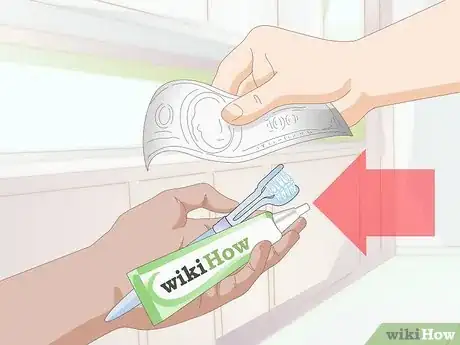

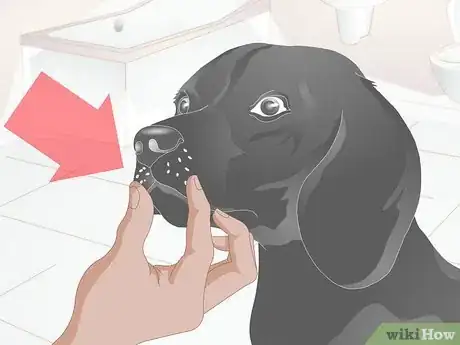
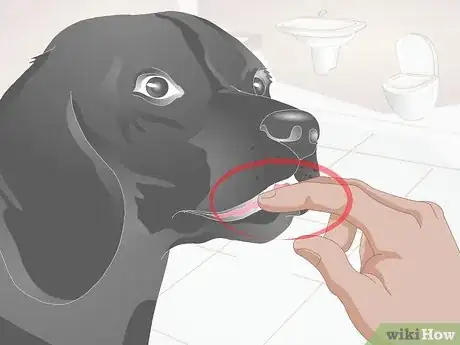


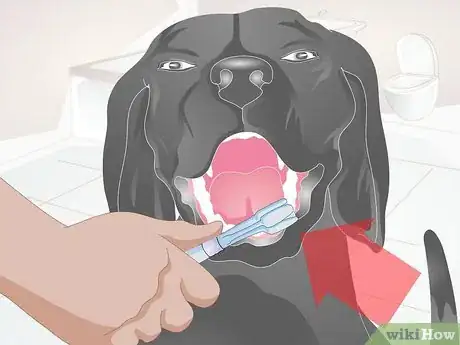
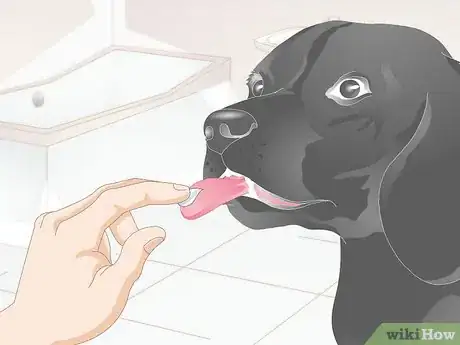
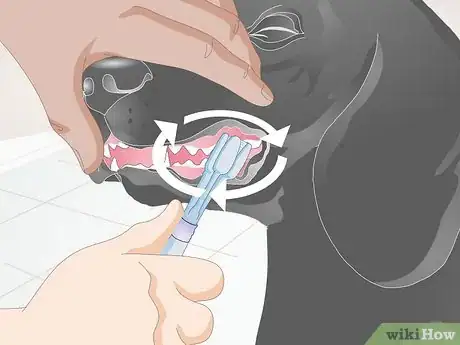
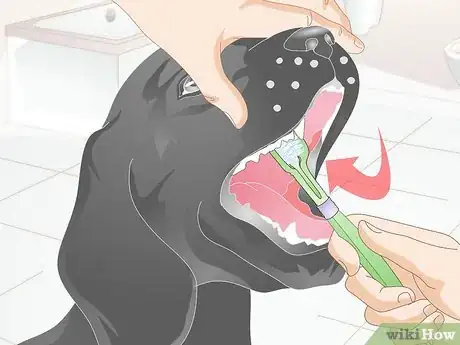

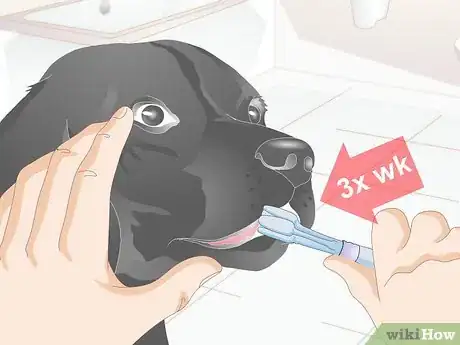
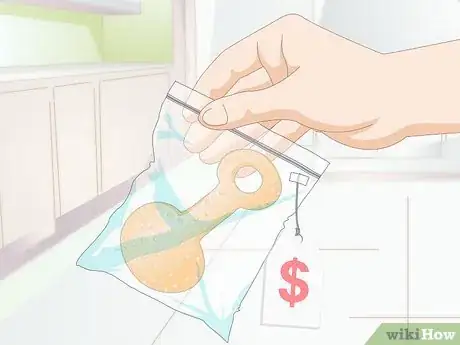
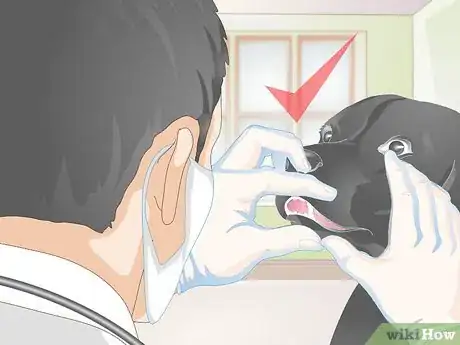
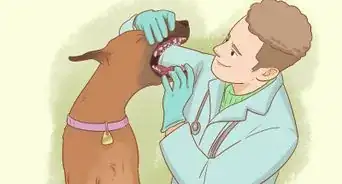
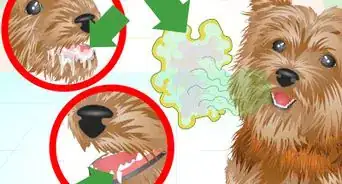
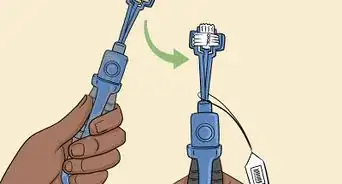
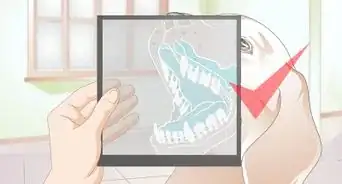
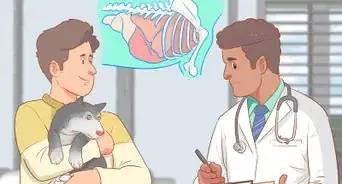






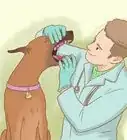

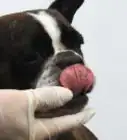
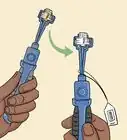



































Medical Disclaimer
The content of this article is not intended to be a substitute for professional medical advice, examination, diagnosis, or treatment. You should always contact your doctor or other qualified healthcare professional before starting, changing, or stopping any kind of health treatment.
Read More...